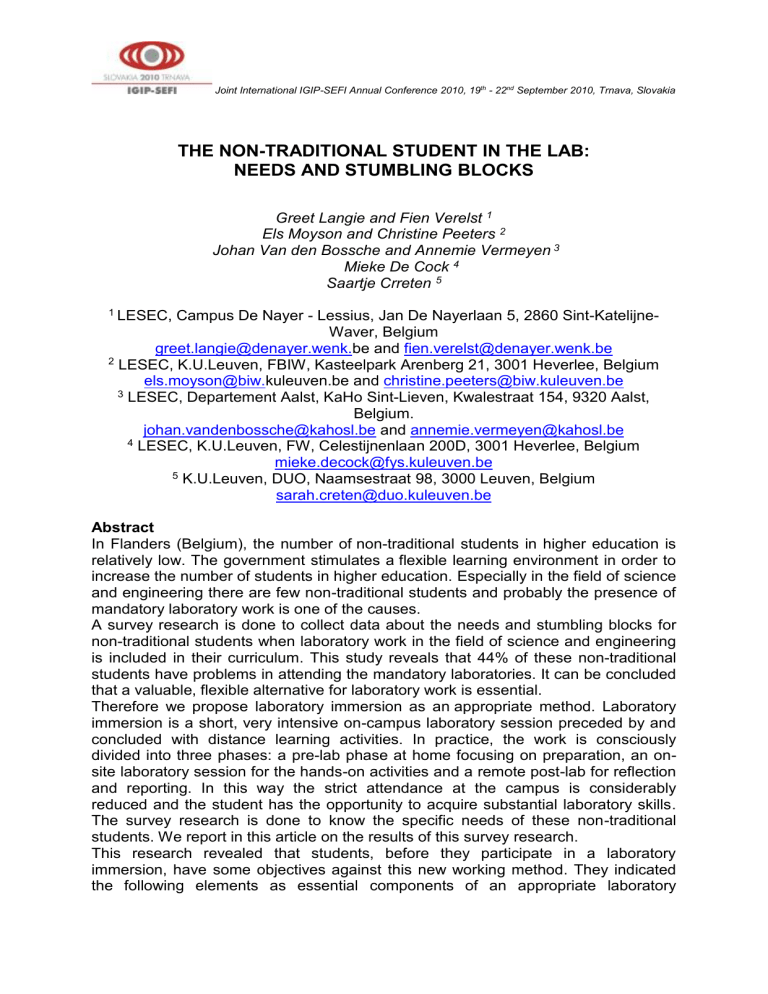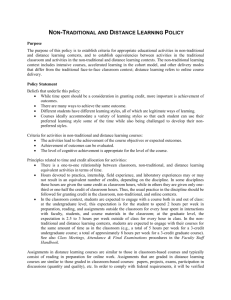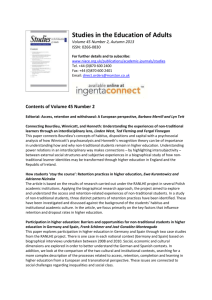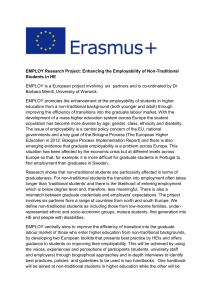View/Open - Lirias

Joint International IGIP-SEFI Annual Conference 2010, 19 th
- 22 nd
September 2010, Trnava, Slovakia
THE NON-TRADITIONAL STUDENT IN THE LAB:
NEEDS AND STUMBLING BLOCKS
Greet Langie and Fien Verelst 1
Els Moyson and Christine Peeters 2
Johan Van den Bossche and Annemie Vermeyen 3
Mieke De Cock 4
Saartje Crreten 5
1 LESEC, Campus De Nayer - Lessius, Jan De Nayerlaan 5, 2860 Sint-Katelijne-
Waver, Belgium greet.langie@denayer.wenk.
be and fien.verelst@denayer.wenk.be
2 LESEC, K.U.Leuven, FBIW, Kasteelpark Arenberg 21, 3001 Heverlee, Belgium els.moyson@biw.
kuleuven.be and christine.peeters@biw.kuleuven.be
3 LESEC, Departement Aalst, KaHo Sint-Lieven, Kwalestraat 154, 9320 Aalst,
Belgium. johan.vandenbossche@kahosl.be
and annemie.vermeyen@kahosl.be
4 LESEC, K.U.Leuven, FW, Celestijnenlaan 200D, 3001 Heverlee, Belgium mieke.decock@fys.kuleuven.be
5 K.U.Leuven, DUO, Naamsestraat 98, 3000 Leuven, Belgium sarah.creten@duo.kuleuven.be
Abstract
In Flanders (Belgium), the number of non-traditional students in higher education is relatively low. The government stimulates a flexible learning environment in order to increase the number of students in higher education. Especially in the field of science and engineering there are few non-traditional students and probably the presence of mandatory laboratory work is one of the causes.
A survey research is done to collect data about the needs and stumbling blocks for non-traditional students when laboratory work in the field of science and engineering is included in their curriculum. This study reveals that 44% of these non-traditional students have problems in attending the mandatory laboratories. It can be concluded that a valuable, flexible alternative for laboratory work is essential.
Therefore we propose laboratory immersion as an appropriate method. Laboratory immersion is a short, very intensive on-campus laboratory session preceded by and concluded with distance learning activities. In practice, the work is consciously divided into three phases: a pre-lab phase at home focusing on preparation, an onsite laboratory session for the hands-on activities and a remote post-lab for reflection and reporting. In this way the strict attendance at the campus is considerably reduced and the student has the opportunity to acquire substantial laboratory skills.
The survey research is done to know the specific needs of these non-traditional students. We report in this article on the results of this survey research.
This research revealed that students, before they participate in a laboratory immersion, have some objectives against this new working method. They indicated the following elements as essential components of an appropriate laboratory
Joint International IGIP-SEFI Annual Conference 2010, 19 th
- 22 nd
September 2010, Trnava, Slovakia immersion: teamwork, frequent contacts with regular students, good coaching by the staff, a comparable study time, an increased flexibility and an emphasis on hands-on.
These elements were incorporated in three pilot projects: microbiology, instrumental chemical analysis and physics. These laboratory immersions were tested during the academic year 2009-2010 and the results will be validated and submitted for a future publication.
Keywords : flexibility, non-traditional students, laboratory work, distance learning
1. Introduction
In 2005 the New Lisbon partnership for growth and jobs was launched. It seeks to reform the continent’s still fragmented systems into a more powerful and more integrated, knowledge based economy. Therefore, it is important to increase lifelong learning opportunities and to widen higher education access to non-traditional and adult learners [1-3]. The project we report on in this paper aims to create a flexible study pathway for these non-traditional students in the field of science and technology.
Laboratory work is an important component in the curriculum of future engineers and scientists [4]. Twenty to sixty percent of the contact moments in scientific and engineering higher education are dedicated to laboratory work.
These are strictly organised, intensively coached learning activities at the campus of the University or
College. The attendance to these on-site training activities is mandatory to the program. Non-traditional students cannot attend all the scheduled sessions, so adhoc solutions are introduced which unfortunately do not always have the same aims as the original practical work or do not fit the required quality standard. We are in need of a structural solution which can be offered to the students when the regular experimental courses in the laboratory can not be taken.
When one designs a structural solution, there should be an awareness of the needs of the non-traditional students. We designed an e-questionnaire, based on semistructured interviews of students [5], to inventarise the ideas of the non-traditional students.
First of all we will discuss the categorization of these non-traditional students and their share in the student population. The barriers these students run into, are discussed afterwards and finally some conclusions are presented.
2. The non-traditional student
In the US a traditional student is rather an exception [6]. Only 27% of all students meet all the following criteria of a traditional student:
the student enrolls full time immediately after finishing high school;
the student depends on parents for financial support;
the student either does not work during the academic year or works part time.
In Europe, the percentage of non-traditional students varies strongly and depends on the country-specific def inition of ‘non-traditional‘ [7]. The share of students with non-
Joint International IGIP-SEFI Annual Conference 2010, 19 th
- 22 nd
September 2010, Trnava, Slovakia traditional routes to higher education is only 8,4%. On the other hand, the share of students studying part-time is 20% or more in eight countries in Europe. More than half of the students in eleven countries combine work and study. In the Netherlands and Estonia this is the case for more than two thirds of the students.
In Flanders (Belgium) more than 97% of the students enter higher education directly from high school [8]. The average number of hours a student spends on a job during the studies is 4 hours/week and only 27% of the students work alongside their studies. In the field of sciences and engineering the amount of hours students spend on working is even less than 3 hours/week. In the field of Science and Technology this results in the following percentages of students who combine a job with studying:
- 19% of the students in Industrial Engineering and Technology;
- 14% of the students in Sciences;
- 12% of the students in Applied Biological Sciences;
- 11% of the students in Applied Sciences.
These percentages are very low compared to the neighbouring countries.
We have counted the number of non-traditional students within some departments of the group ‘Science and Technology’ of the K.U.Leuven in October 2008. Four types of non-traditional student were defined:
- Type I: combines a full-time job with his/her study;
- Type II: combines top sport with his/her study;
- Type III: learns as much as possible at home using distance education;
- Type IV: selects independently his/her courses resulting in the coincidence of courses. .
The total number of non-traditional students was 24,8% (1% type I, 0,3% type II,
0,4% type III and 23,1% type IV). There are several reasons to explain this low number of non-traditional students in the field of science and technology in Flanders.
One of the reasons is the fact that they cannot attend all scheduled lab sessions.
Since laboratory work is an important component in the curriculum of engineers and scientists, the attendance to these on-site training activities is mandatory in the program.
2. The non-traditional student in the lab
We propose laboratory immersion as an appropriate solution. Laboratory immersion is a short, very intensive on-campus laboratory session preceded by and concluded with distance learning activities. This concept is already implemented in the Open
Universities (intensive laboratory weeks) and in some projects at other universities
[9-12].
The offered facilities should meet the student’s needs. Therefore the first three steps in this project, before the design of the laboratory immersion, were the development, the acquisition and the handling of a survey focusing on the needs and the problems of these non-traditional student.
Joint International IGIP-SEFI Annual Conference 2010, 19 th
- 22 nd
September 2010, Trnava, Slovakia
3. The survey
3.1 The preparation
The first step was a semi-structured interview with 7 different individual nontraditional students [5]. Nine open-ended questions were presented and answered. In this way, we got an overview of the most probable answers to our 28 multiple choice questions of the survey. Most of them are based on aided recall.
3.2 The acquisition
The survey was organized electronically and took on average five minutes for every student. It was presented to 601 students and completed by 137 non-traditional students of 5 different institutions within the Association K.U.Leuven. This results in a response rate of 23%.
4 The results
Three different topics were discussed: the situation of the student, the regular lab and a possible alternative i.e. a laboratory immersion.
4.1 The situation of the student
Most respondents were bachelor students. This is important in the context of maturity and the ability to act independently. Moreover the laboratory courses in the bachelor years consist of repeated contact moments for the same topic. If students are not able to go to a specific laboratory session, they can choose another moment which is more suitable. 77% of the respondents were classified as type IV. These students deviate from the regular study path and have by consequence coinciding courses.
4.2 The regular lab
In 88% of the laboratories the students are obliged to be present in the laboratory.
The survey revealed that 44% of the respondents have problems attending all the scheduled lab sessions; 38% of them effectively missed one or more compulsory sessions (see table 1).
Table 1 : Could you attend all the obligatory laboratory sessions?
Yes
Yes, but it took a lot of energy.
56%
7%
Yes, but only because I attended the lab together with another group at another moment. 19%
No, I had to work. 4%
No, I had to attend two different courses.
No, I had to attend a sport manifestation.
No, the laboratory moved suddenly to another moment.
Other answer
11%
0%
4%
4%
A consequence of this problem is that many contacts between students and staff are needed in order to organize a lab for catching up. Students who missed lab sessions, missed mostly one or two sessions. If they missed a lab session, most of them catched up this session with another group of students at another moment (see
Table 2).
Joint International IGIP-SEFI Annual Conference 2010, 19 th
- 22 nd
September 2010, Trnava, Slovakia
Table 2 : How did you solve the problem of being not capable to attend a lab session?
I attended the lab session at another moment with another group.
I catched up individually.
47%
15%
I prepared a replacement task. 13%
I didn’t do the lab and found an excuse which was approved by the teacher. 19%
I didn’t do the lab. 6%
I wrote my name on the report of another group, but didn’t participate.
I didn’t participate, the teacher didn’t notice.
0%
0%
Other possibility 0%
The observation that a high number of students did not attend the obligatory lab session with the approval of the teacher is very alarming.
97% of the respondents agreed that the laboratory sessions in their study are important, mainly because they feel the need for practical experience.
Only 10% of the students prefer to work alone in the lab. The reasons why the respondents prefer teamwork are:
- two students know more than one;
- during the lab sessions, they meet regular students and receive important
(informal) information about other courses.
4.3 The alternative: laboratory immersion
Almost half of the respondents (43%) has problems with the larger responsibility typical of a laboratory immersion and 63% fears more work. 82% prefers to work in team during the laboratory immersion. Only 16 out of 137 respondents (12%) prefer the laboratory immersion over the regular laboratories. Significant reasons are:
I will miss the group;
I don’t like to study alone on my computer;
I don’t want to be considered as special;
I will miss the contact with the staff;
I will miss important information about other courses;
I will have to work too hard.
Arguments in favour of the laboratory immersion are:
I will have a greater amount of flexibility;
I will still have hands-on experience;
I will be able to work at my own pace.
Some non-traditional students suggested to take into account their previous experience. And some students suggested to organize these laboratory immersion all together on one day.
Joint International IGIP-SEFI Annual Conference 2010, 19 th
- 22 nd
September 2010, Trnava, Slovakia
4.4 Do working students (type I) have other needs?
Only 16 respondents (1,0%) are of type I, but nevertheless the main conclusions are worth mentioning.
Working students do have more problems with attending labs. Their solution is most of the time a replacement task or an acceptable excuse. They have less problems with the increased level of responsibility. But, they still prefer the regular laboratories to laboratory immersion, although their preference is less pronounced. Their arguments are comparable to the ones of the other non-traditional students.
5. Conclusions
The enthusiasm for the alternative track of laboratory immersion is not very high.
A possible reason is the relative low number of non-regular students in our higher education. So the teaching staff is often prepared to organize additional moments to catch up for every individual student.
A second possible explanation is the simplicity of some replacement tasks. The students prefer to walk the track of lowest resistance (not participating, writing a paper…).
Moreover, the laboratory courses in the bachelor years consist of repeated contact moments for the same topic If students are not able to go to a specific session, they can choose to attend the same lab session at a moment that is more suitable for them.
In case a laboratory immersion is scheduled, following elements should be taken into account, according to the students:
1. The students should be able to work in team (in all three phases of the laboratory immersion).
2. The hands-on phase is an important element which should not be skipped.
3. The total study time needs to be comparable to the regular labs.
4. The coaching during the immersion is an important element. Students fear less support and larger responsibility. This is probably partially due to the fear for the unknown since this survey is organised before their participation in the laboratory immersion.
5. The laboratory immersion should become a flexible tool with respect to time, and location. This profit should exceed all the disadvantages.
6. Non-traditional students are in need of contacts with traditional students. In case they do not have this opportunity during the lab session, other occasions must be established. It is important to remind that non-traditional students have a greater withdrawal. Laing [13] has shown that providing a helpful and well informed teaching environment is one of the essential emergent properties.
These elements have been incorporated in the three laboratory immersion pilot projects which are tested during the academic year 2009-2010. The results of these pilot projects will be submitted for publication.
Acknowledgements
This project is realised thanks to the financial support of ‘het onderwijsontwikkelingsfonds van de Associatie K.U.Leuven’.
Joint International IGIP-SEFI Annual Conference 2010, 19 th
- 22 nd
September 2010, Trnava, Slovakia
References
[1] COUNCIL OF THE EUROPEAN UNION. Council Resolution on modernizing universities for Europe's competitiveness in a global knowledge economy – adoption of Council Resolution . Brussels, December 6th 2007.
[2] European Commission Education & Training. Higher Education in Europe (online) .
http://ec.europa.eu/education/lifelong-learning-policy/doc62_en.htm
[november 2008 ].
[3] COMMISSION OF THE EUROPEAN COMMUNITIES. Progress towards the Lisbon objectives in education and training, Indicators and benchmarks 2008 (online).
http://ec.europa.eu/education/policies/2010/progressreport_en.html
[ november 2008 ].
[4] Edward, N. (2002). The role of laboratory work in engineering education: student and staff perceptions.
International Journal of Electrical Engineering Education, 39 (1), 9 pages.
[5] Verelst, F., Langie, G., Moyson, E., Peeters, C., Vermeyen, A., Van den Bossche, J., De Gruyter, J., Colen, W.,
Creten, S. and Verheyden, J. (2009). Breaking barriers in laboratory education for non-traditional students.
Conference proceedings, EADTU 2009 Maastricht.
[6]
[7]
[8]
[9]
[10]
[11]
[12]
[13]
The condition of Education 2002, National Center for education statistics, US Department of Education
( http://nces.ed.gov/Pubsearch/pubsinfo.asp?pubid=2002025 ).
Social and economic conditions of student life in Europe, Synopsis of indicators, Final Report, Eurostudent III 2005-
2008 ( http://www.eurostudent.eu/ ).
Studentenmonitor Vlaanderen 2008-2009, Socio-economische kenmerken van studenten in het Hoger Onderwijs
( http://www.ond.vlaanderen.be/hogeronderwijs/publicaties/Studentenmonitor_Vlaanderen_2009.pdf
).
Strnadova, R., S. Wyss, M. Lussi Bell, Miller D., and K. Kovar (2005). www.biotechLAB.net - Learning environment based on approved principles. Conference proceedings: Villach ICL 2005 (online). http://www.researchportal.ch/unizh/p6849.htm
[November 2008].
Sancho, P., Corral, R., Rivas, T., Gonza´lez, M., Chordi, A. & Tejedor, C. (2006). A Blended Learning Experience for Teaching Microbiology. American Journal of Pharmaceutical Education, 70 (5) , 1-9.
UMC News, University of Minnesota. Microbiology Instructor Uses Internetbased “Hybrid” Course (online). http://www.umcrookston.edu/newsevents/notices01-02/KnutsonClass.htm
[November 2008].
Buiu, C. (2008). Hybrid Educational Strategy for a Laboratory Course on Cognitive Robotics. IEEE
TRANSACTIONS ON EDUCATION, 51 (1), 100-107.
Laing, C. and Robinson, A. (2003) The withdrawal of non-traditional students: developing an explanatory model.
Journal of further and higher education, Vol 27, No 2.






